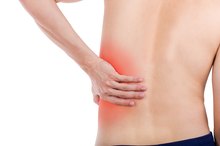Causes of Lower Back Pain on the Right Side
Lower back pain on the right side can have many causes. The backbone, or spine, is made of an intricate arrangement of bones and ligaments extending from the neck to the pelvis.
The part of the spine located in the lower back is known as the lumbar spine.
The bones -- called vertebrae -- form a canal containing the spinal cord and nerves exiting the cord. Muscles surround the spine, allowing movement and providing support. The lower back also includes the sacroiliac joints, which connect the lowermost spinal bone to the pelvic bones.
Problems may arise in any of these structures, producing pain on the right side of the lower back.
Pain in this area may also arise from disorders located within the pelvis or abdomen. Some of the most common causes of right-sided lower back pain are sprains and strains, herniated lumbar discs and sacroiliac joint injuries.
Sprains and Strains
Stretching or tearing of muscles (called strains) or ligaments (called sprains) are common causes of lower back pain. When they occur on just the right, pain will be localized to that side. The quadratus lumborum is one of several muscles in the back that can produce 1-sided lower back pain if strained. Lower back strains and sprains are often caused by twisting movements, improper lifting techniques, and lifting heavy objects. The pain may be quite severe, especially with activities that involve movements at the waist.
Herniated Lumbar Disc
Symptoms of an L5-S1 Degenerative Disc
Learn More
A herniated, or ruptured, disc occurs when part or all of the disc material located between adjacent vertebrae moves from its proper location. When a disc in the lumbar spine herniates, it will press on nerves and other structures in the area.
Right-sided lower back pain will occur if the disc presses on nerves exiting the spinal cord on the right.
The resulting pain is often sharp or burning and may travel beyond the lower back into the right buttocks or leg. Numbness, pins and needles sensations and muscle weakness may also occur in these areas.
Herniated discs are often caused by gradual deterioration of the disc during the natural aging process. They may also be caused by actions that place excessive stress on the disc, such as sudden back movements or lifting heavy objects.
- A herniated, or ruptured, disc occurs when part or all of the disc material located between adjacent vertebrae moves from its proper location.
- The resulting pain is often sharp or burning and may travel beyond the lower back into the right buttocks or leg.
Sacroiliac Joint Injury
Right sacroiliac joint injuries may cause right-sided lower back pain. Each sacroiliac joint -- 1 on each side of the body -- connects the lowest spinal bone called the sacrum to a pelvic bone called the ilium.
Sacroiliac joints can be injured by twisting movements involving the lower back or by prolonged sitting. Injuries are more likely to occur in people with too much or too little movement in these joints.
Sacroiliac joint pain can range from deep, dull and achy to sharp and stabbing. It may remain localized to the joint area or move down into the buttocks or thigh.
- Right sacroiliac joint injuries may cause right-sided lower back pain.
- Sacroiliac joints can be injured by twisting movements involving the lower back or by prolonged sitting.
Other Spine Causes
Causes of Lower Left-Side Abdominal Pain
Learn More
Any other disorder affecting the lumbar spine can produce right lower back pain if it leads to pressure on nerves exiting the spinal cord on the right. Arthritis of the lumbar spine facet joints and lumbar spinal stenosis -- overgrowth of spinal bones, producing a narrowed spinal canal -- are disorders that often compress these nerves.
Fractures of lumbar vertebrae, due to either a significant injury or osteoporosis, are another possible cause. Less commonly, the nerves are compressed by tumors and infections involving the spine.
- Any other disorder affecting the lumbar spine can produce right lower back pain if it leads to pressure on nerves exiting the spinal cord on the right.
- Arthritis of the lumbar spine facet joints and lumbar spinal stenosis -- overgrowth of spinal bones, producing a narrowed spinal canal -- are disorders that often compress these nerves.
Non-Spine Disorders
Right kidney infections may produce right-sided lower back pain. Fever, nausea and vomiting are often present as well. A stone arising from the right kidney is another possible cause.
Kidney stone pain typically occurs as spasms that can be very severe. Nausea, vomiting and blood-tinged urine may accompany the pain.
Right lower back pain is sometimes caused by gynecologic conditions, such as pelvic inflammatory disease and endometriosis.
Inflammatory bowel disease, appendicitis and other gastrointestinal disorders are other potential causes. With gastrointestinal disorders, abdominal pain and other symptoms, such as nausea, vomiting and diarrhea, are usually more prominent than back pain.
- Right kidney infections may produce right-sided lower back pain.
- With gastrointestinal disorders, abdominal pain and other symptoms, such as nausea, vomiting and diarrhea, are usually more prominent than back pain.
When to Seek Medical Attention
See your doctor if your back pain is not relieved with rest, applying heat or cold and taking over-the-counter medications.
Also see your doctor if your pain is not beginning to improve after a few days or if it is worsening. Obtain prompt medical care if your back pain is accompanied by other symptoms, such as numbness or weakness of 1 leg, unexplained weight loss, fever, nausea, vomiting or changes in your urine.
Seek immediate medical attention if you have numbness or weakness of both legs or loss of bowel or bladder control. Also seek immediate medical care if your back pain was caused by a significant injury, such as a fall or motor vehicle accident.
Reviewed and revised by Mary D. Daley, M.D.
- See your doctor if your back pain is not relieved with rest, applying heat or cold and taking over-the-counter medications.
- Obtain prompt medical care if your back pain is accompanied by other symptoms, such as numbness or weakness of 1 leg, unexplained weight loss, fever, nausea, vomiting or changes in your urine.
Related Articles
References
- Spine-Health: Lumbar Herniated Disc -- What You Should Know
- National Institute of Neurological Disorders and Stroke: Low Back Pain Fact Sheet
- Spine-Health: Lumbar Herniated Disc Symptoms
- American Family Physician: Diagnosis and Treatment of Acute Low Back Pain
- American Family Physician: Chronic Low Back Pain -- Evaluation and Management
- Merck Manual Consumer Version: Low Back Pain
- Peebles R, Jonas CE. Sacroiliac joint dysfunction in the athlete: diagnosis and management. Curr Sports Med Rep. 2017;16(5):336-342. doi:10.1249/JSR.0000000000000410
- Medlineplus, Herniated Disk
- National Institute of Neurological Disorders and Stroke. Low back pain fact sheet. Updated December 2014.
Writer Bio
Martin Hughes is a chiropractic physician, health writer and the co-owner of a website devoted to natural footgear. He writes about health, fitness, diet and lifestyle. Hughes earned his Bachelor of Science in kinesiology at the University of Waterloo and his doctoral degree from Western States Chiropractic College in Portland, Ore.





